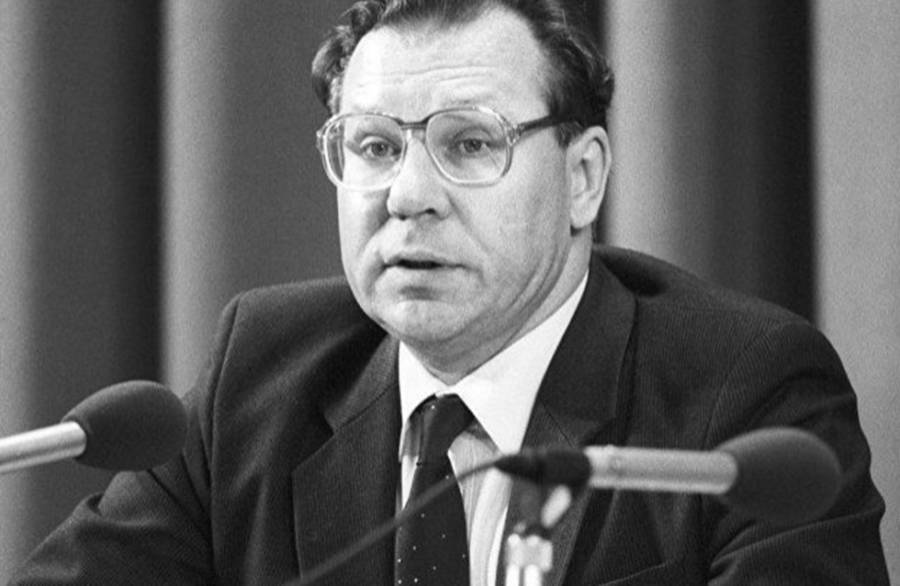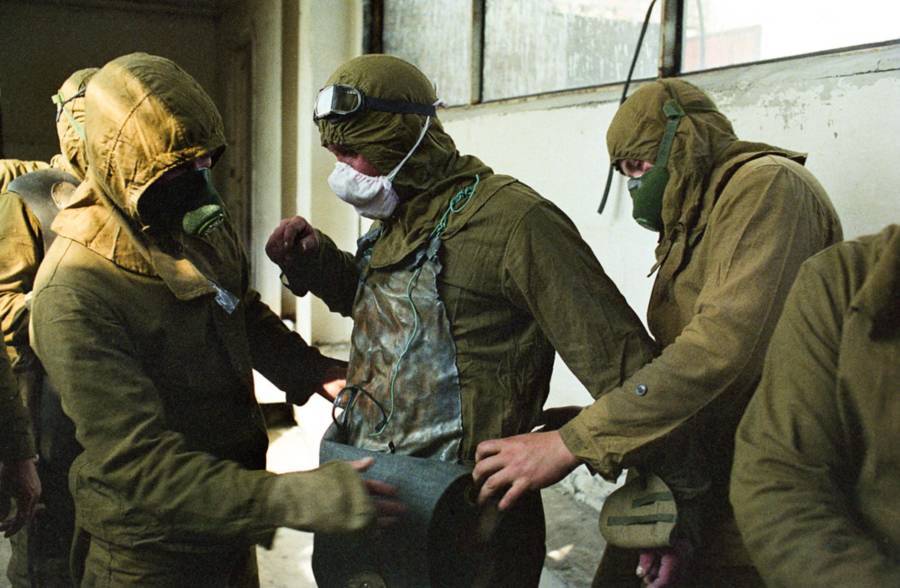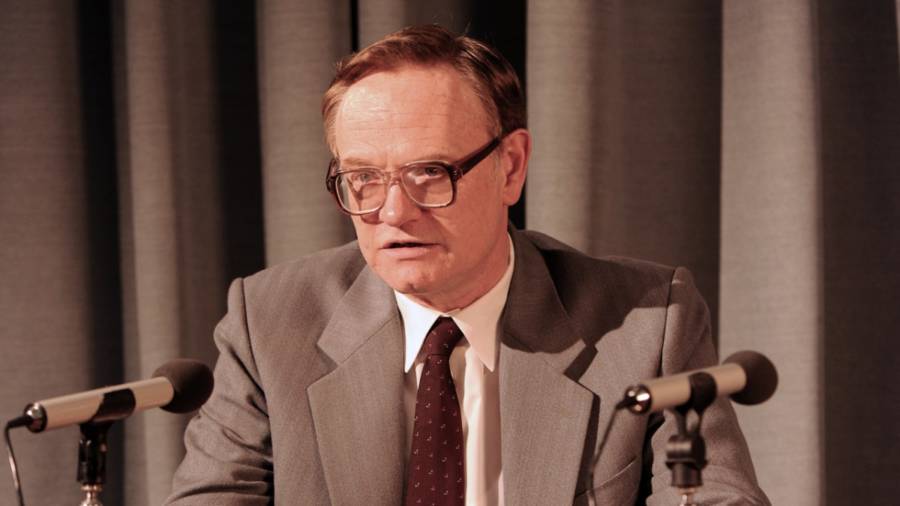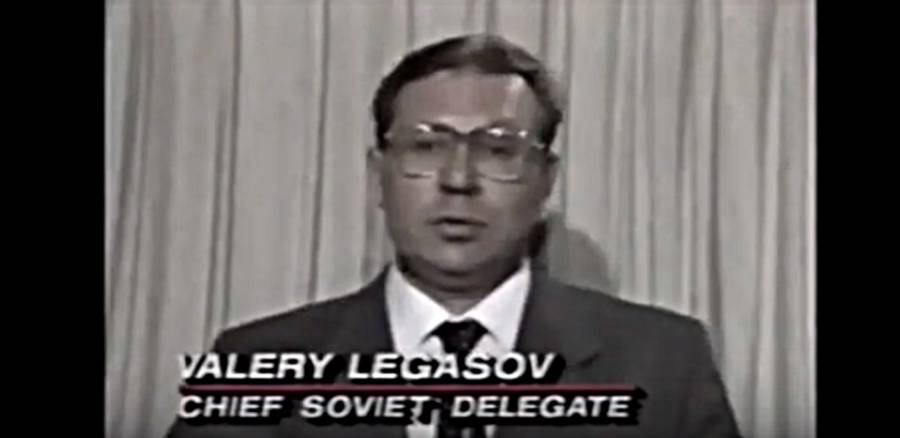Valery Legasov was a respected chemist who led the investigation behind what caused the meltdown at Chernobyl. Two years later, he ended his own life unexpectedly.
Soviet nuclear physicist Valery Legasov led the commission that investigated the Chernobyl catastrophe.
He was a proponent of transparency between the commission’s findings and the public in spite of the Soviet Union government’s efforts to downplay the disaster. Many credit him as the sole rational figure involved in the fallout of the catastrophe as it was Legasov who was responsible for launching the immediate remedies to Chernobyl’s long-term effects.

ExpressValery Legasov presents his report in the Chernobyl investigation.
Unfortunately, Legasov would commit suicide two years later — just one day after the second anniversary of the explosion. He left behind a slew of notes and tapes in which he voiced his disillusionment with his government.
Some even believed that it was what he learned about his government’s involvement in the disaster that led him to such fatal despair.
Valery Legasov Is Summoned To Chernobyl
https://www.youtube.com/watch?time_continue=5&v=C8baB4Tj7NI
After reactor four at the Chernobyl Nuclear Power Plant in Soviet Ukraine short-circuited and exploded, fire from the explosion blazed for 10 days straight releasing tons of radioactive nuclear particles into the open air over Europe resulting in sickness, displacement, and death.
Physicist Valery Legasov first learned about the nuclear explosion at Chernobyl while listening to a morning talk at the Kurchatov Institute of Atomic Energy, where he sat as deputy director. The speaker mentioned that at Chernobyl, “there has been some kind of accident,” and by midday, roughly 12 hours after the Chernobyl nuclear plant exploded, Legasov was appointed to the government’s special commission to handle the fatal incident.
Deputy Chairman of the Council of Ministers and Head of the Bureau for Fuel and Energy, Boris Shcherbina, was selected as head of the investigation, but it was Legasov who would become the face of the aftermath efforts. Legasov, along with numerous scientists, military officers, and ministers on the commission, was on the next flight to Kiev, and from there on to Pripyat, the nearest town to the nuclear catastrophe.
About six miles from the plant, Legasov could see a foreboding red glow in the night sky.
Local authorities managed to evacuate 300,000 residents living in those towns closest to the disaster, but many residents received the evacuation notice later than others as it was passed mainly by word of mouth. As such on the morning following the incident, Legasov noted, “mothers…pushing prams and children were playing in the street – just like any other Sunday.” When these remaining citizens were finally evacuated, Legasov further remarked with some reticence that many left in their own cars which could have potentially been contaminated.
The abandoned section remains so today and is known as Chernobyl’s exclusion zone. The surrounding forest turned crimson in the fallout, earning it the name the Red Forest, and save for the reemergence of wildlife, is said to remain too toxic for human habitation for the next 20,000 years.
Legasov and the investigation committee observed the site by helicopter because radiation levels were so high. The combustion fire in the plant could only be put out by air as well from a height of more than 900 feet from the reactor. Overall, it became clear to Legasov that the plant workers, while eager to help, had no practical means of doing so.
For one thing, Legasov described how there was no organization within the USSR that could deal with the situation. Consequently, the proper equipment with which the disaster required were in short order. There weren’t enough respirators or radiation-detecting instruments. Legasov required foreign assistance, too, and took suggestions from abroad regarding how to handle graphite fires using various chemical mixtures.
The whole of the situation was, according to Valery Legasov, the “apotheosis of all that was wrong in the management of the national economy and had been so for many decades.”
Valery Legasov’s Disheartening Report

MIT Technology ReviewEmergency workers cleaning up radioactive debris in nearby Pripyat.
It was determined by Legasov’s team that the disaster at Chernobyl was caused by multiple factors. First, the Soviet-designed reactor, Bolsho Moshchnosty Kanalny or RMBK, was faulty and unstable and actually banned from use anywhere else besides the Soviet Union.
Some reports noted that experts had even cautioned the Soviet government on the use of this reactor, especially because the reactor lacked a protective layer to contain any radioactive materials in the event of a leak or exposure. The warnings, evidently, went unheeded.
Second, the plant was operated by untrained workers whose improper handling of the reactor equipment only added to the disaster. In fact, on the night of the explosion the operators, led by deputy chief engineer Anatoly Dyatlov, had executed an allegedly unauthorized experimental safety test that led to the reactor’s short-circuit and subsequent meltdown.
“In those terrible days,” as Valery Legasov noted, there appeared also a glimmer of hope. Many were eager to help however they could and some even sacrificed their lives to reduce the devastation of the incident.

Igor Kostin/Sygma/CorbisSpecial clean-up workers, known as “liquidators” tasked with clearing the radioactive materials, suit up.
In August 1986, Legasov headed to Vienna, Austria for a conference by the International Atomic Energy Agency to present the Soviets’ report on the cause of the disaster at Chernobyl. During the five-hour hearing, Legasov stated that human error combined with the faulty design of the reactor were the primary causes of the incident. He did, however, stress that human negligence and unpreparedness was the bigger factor in what caused the incident.
“Neglect by the scientific management and the designers was everywhere with no attention being paid to the condition of instruments or of equipment,” Legasov wrote in his report.
Many from the international community applauded Legasov’s detailed and frank review of the circumstances in the aftermath of the meltdown. It was a deep contrast to the attitude of the majority of power players in the Soviet government who had tried to downplay the extent of the catastrophe. Further, Legasov was lauded for his commitment. He did not leave the site until the situation was contained, unlike other members of the emergency team who rotated out of the Chernobyl to avoid contamination.
“Today we are living in such a world that we are surrounded by many technologically complex, potentially dangerous systems both nuclear and non-nuclear. Without those systems, we cannot develop, but nonetheless they are dangerous,” Legasov said in an interview with NBC News. “That is why it is important to work very hard to ensure that the safety of all technologically complex systems — nuclear, chemical, biological — should be enhanced.”
But two years later, on the eve following the disaster’s second anniversary, Legasov was found dead by suicide. He was 51 years old.
Reality Versus Fiction
Legasov had hanged himself and though he left no suicide note, he did leave behind a slew of recordings in which he described his disillusionment with the Soviet government while investigating the meltdown. The government, Legasov found, had tried to hide integral information regarding the disaster.
Vladimir Gubarev, a close friend of Valery Legasov’s who wrote the popular play Sarcophagus based on Chernobyl, told local publication Pravda that Legasov was ridiculed by his colleagues for his handling of the accident despite receiving international praise for it. He was excluded by a 129-100 vote of his peers from a seat on the scientific and technical council of the Kurchatov Institute of Atomic Energy, where he was once a deputy director.
Gubarev supposed that this could have been in part responsible for his friend’s suicide.
“I felt like saying to them that Legasov never left Chernobyl, but how come I did not see you there,” Gubarev said. He added that Lugasov was especially disappointed to learn that he was the only member of the Chernobyl disaster team who was not awarded the title “hero of socialist labor,” which was a prestigious national award. Others suspected that domestic issues were the cause of his suicide, while still, others believed that Legasov somehow blamed himself for the suffering caused by Chernobyl. Regardless, the truth behind his demise remains unclear.
In December of 2000, 14 years after the world was exposed to the horrors of Chernobyl, the last of the remaining reactors at the Chernobyl nuclear plant were shut down. Up to that point, the three other reactors remained an integral generator for Ukraine’s power. Reactor two had closed in 1991 and unit one five years later.

HBOActor Jared Harris plays lead physicist Valery Legasov in the HBO series Chernobyl.
In 2019, HBO launched their miniseries Chernobyl. The show opens with a scene of Valery Legasov contemplating the disaster years after it has happened, setting him up as the show’s unrelenting protagonist.
“If we hear enough lies, then we can no longer recognize the truth at all. What can we do then?” his character, portrayed by actor Jared Harris, wonders.
It’s always difficult to create a show based on real events because there are often details that are forgotten or ignored, typically leading to criticism from those who have actually lived said events. But Chernobyl has proved that authenticity does not have to be compromised for creativity.
The series so far has earned praise from TV critics for its haunting yet masterful portrayal of the unfolding nuclear disaster. The Moscow Times, for instance, praised the show as “a crash course in nuclear physics, but more importantly, it is a thought-provoking exploration of the importance of truth and the nature of self-sacrifice.”
Those who are old enough to remember the Chernobyl disaster have also expressed approval of the show’s production value and the immense work that the team behind it — led by writer-producer Craig Mazin — obviously poured into their research.
Slava Malamud, who grew up in the Soviet Union and now works as a sports writer, tweeted that “Everything, and I mean everything so far has been incredibly authentic. The typical provincial babushkas talking outside, the kitchen supplies and utensils, the white ‘celebratory’ uniforms of school children.” He added that “I’m impressed by much more than the mere minutiae of Soviet everyday life… Chernobyl is much more true to life than any Western show about Russia..”
However, all this praise of the show’s authenticity does not mean that they did not also take some creative liberties, particularly with the characters on the show which were based on real figures involved in the disaster’s aftermath.

YouTubeValery Legasov interviewed by U.S. media about his Chernobyl report.
Author of nonfiction bestseller Midnight in Chernobyl, Adam Higginbotham, applauded the production but pointed out some of the dramatizations, too. He noted that Legasov was a radiochemistry expert in real life, not a reactor specialist, so he received a lot more guidance from other specialists in his investigation than the series let on.
As for the portrayal of Valery Legasov, the author who spent years interviewing people involved in the accident researching old documents, speaking with friends and colleagues of Legasov including his daughter, claimed that his personality in the show was mostly fiction.
Legasov was posthumously awarded “Hero of the Russian Federation” on September 20, 1996. Then Russian president Boris Yeltsin stated that Legasov deserved the distinction for the “courage and heroism” he displayed in his investigation.
After learning the true story of Valery Legasov, read about how radioactive boars are keeping people from returning home to Fukushima. And then, learn the story of the radioactive sludge that is leaking out of a nuclear dome — and into the Pacific.





